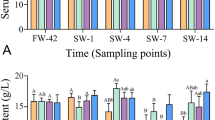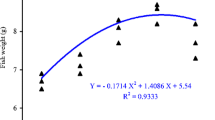Abstract
In the present study, Labeo rohita juveniles previously fed with tryptophan (TRP) supplemented diet for 60 days were exposed to temperature and salinity stress for the next 30 days with the same feeding regime to evaluate the stress mitigating efficacy of TRP. After 30 days of exposure to temperature and salinity, the stress exposed groups recorded higher aspartate amino transferase (AST), alanine amino transferase (ALT) and lactate dehydrogenase (LDH) activities as compared to control. In, liver and muscles, the highest activities of LDH, AST and ALT were observed in TRP0+S+T followed by TRP0+T and TRP0+S groups. Dietary supplementation of TRP was found to significantly reduce the activities of these enzymes in both the tissues. The lowest and highest acetylcholine esterase activity was evidenced in TRP0+S+T and TRP0+NS (control) groups respectively. The serum chloride concentration and serum osmolarity of L. rohita juveniles were significantly increased upon salinity exposure while temperature did not cause any significant change. The lowest concentration of sodium was observed in TRP0+NS while all other salinity exposed groups recorded higher values. A reverse trend was noticed in case of serum potassium concentration, being highest in TRP0+NS. The dietary supplementation of TRP had no significant effect in modulating the potassium as well as chloride concentration. The results of the present experiment suggest that exposure to temperature and salinity alters the serum electrolytes and osmolarity and dietary supplementation of tryptophan helps in ameliorating the stress as evidenced by various enzymic responses.
Similar content being viewed by others
References
Akhtar MS, Pal AK, Sahu NP, Alexander C, Gupta SK, Choudhary AK, Jha AK (2010) Stress mitigating and immunomodulatory effect of dietary pyridoxine in Labeo rohita (Hamilton) fingerlings. Aquac Res 41(7):991–1002
Hochachka W, Somero GN (2002) Biochemical adaptation: mechanism and process in physiological evolution. Oxford University Press, Oxford
Jonassen TM, Imsland AK, Stefansson SO (1999) The interaction of temperature and fish size on growth of juvenile halibut. J Fish Biol 54:556–572
Massoud FI (1974) Salinity and alkalinity as soil degradation hazards. FAO/UNDP, expert consultation on soil degradation. FAO, Rome, p 21
Akhtar MS, Pal AK, Sahu NP, Ciji A, Meena DK, Das P (2013) Physiological responses of dietary tryptophan fed Labeo rohita to temperature and salinity stress. J Anim Physiol Anim Nutr. doi: 10.1111/jpn.12017
Sardella BA, Matey V, Cooper J, Gonzalez RJ, Brauner CJ (2004) Physiological, biochemical and morphological indicators of osmoregulatory stress in ‘California’ Mozambique tilapia (Oreochromis mossambicus × O. urolepis hornorum) exposed to hypersaline water. J Exp Biol 207:1399–1413
Tejpal CS, Pal AK, Sahu NP, Jha AK, Muthappa NA, Sagar V, Rajan MG (2009) Dietary l-tryptophan mitigates crowding stress and augments the growth in Cirrhinus mrigala fingerlings. Aquaculture 293:272–277
Lepage O, Tottmar O, Winberg S (2002) Elevated dietary l-tryptophan counteracts the stress-induced elevation of plasma cortisol in rainbow trout (Oncorhynchus mykiss). J Exp Biol 205:3679–3687
Hseu JR, Lu FI, Su HM, Wang LS, Tsai CL, Hwang PP (2003) Effect of exogenous tryptophan on cannibalism, survival and growth in juvenile grouper, Epinephelus coioides. Aquaculture 218:251–263
Hoseini SM, Hoseini SA (2010) Effect of dietary l-tryptophan on osmotic stress tolerance in common carp, Cyprinus carpio, juveniles. Fish Physiol Biochem 36:1061–1067
Abidi SF, Khan MA (2010) Dietary tryptophan requirement of fingerling rohu, Labeo rohita (Hamilton), based on growth and body composition. J World Aquac Soc 41:700–709
Cunniff PA (ed) (1995) Official methods of analysis of the association official analytical chemists, vol 1, 16th edn. AOAC International, Arlington, pp. 31–65
Sastry CSP, Tammuru MK (1985) Spectrophotometric determination of tryptophan in protein. J Food Sci Tech 22:146–147
Mateen A, Afzal M, Ahmed I, Hafeez-Ur-Rehman M (2004) Salinity tolerance of rohu (Labeo rohita) and its hybrid under different temperature regimes. Int J Agric Biol 6(6):1030–1032
Wooten IDP (1964) Microanalysis. In: Churchill J, Churchill A (eds) Medical biochemistry, 4th edn. J and Α Churchill Ltd., London, pp 101–107
Wrobleuiski L, Ladue JS (1955) LDH activity in blood. Proc Soc Exp Biol Med 90:210–213
Hestrin S (1949) The reaction of acetylcholine esters and other carboxylic acid derivatives with hydroxylamine and its analytical application. J Biol Chem 180:249–261
Augustinsson KB (1957) The reaction of acetylcholine esters and other carboxylic acid derivatives with hydroxylamine and its analytical application. J Biol Chem 180:249–261
Ciji A, Sahu NP, Pal AK, Akhtar MS (2013) Physiological changes in Labeo rohita during nitrite exposure: detoxification through dietary vitamin E. Comp Biochem Physiol C 158:122–129
Akhtar MS, Pal AK, Sahu NP, Ciji A, Meena DK (2012) Effects of dietary pyridoxine on growth and physiological responses of Labeo rohita fingerlings reared at higher water temperature. Isr J Aquac Bamid 64:777
Bretaud S, Toutant JP, Sagillo P (2000) Effects of carbofuran, diuron and nicosulfuron on acetylcholinesterase activity in gold fish (Carassius auratus). Ecotoxicol Environ Saf 47:117–124
Dembele K, Haubruge E, Gasper C (2000) Concentration effects of selected insecticides on brain acetylcholinesterase in common carp (Cyprinus carpio). Ecotoxicol Environ Saf 45:49–54
Neeraj K, Prabhu AJP, Pal AK, Remya S, Aklakur M, Rana RS, Gupta S, Raman RP, Jadhao SB (2011) Anti-oxidative and immuno-hematological status of Tilapia (Oreochromis mossambicus) during acute toxicity test of endosulfan. Pest Biochem Physiol 99:45–52
Tejpal CS (2007) Dietary l-tryptophan mitigates crowding stress in Labeo rohita fingerlings. MFSc thesis, Central Institute of Fisheries Education, Mumbai, India, p 163
Ciji A, Sahu NP, Pal AK, Dasgupta S, Akhtar MS (2012) Alterations in serum electrolytes, antioxidative enzymes and haematological parameters of Labeo rohita on short-term exposure to sublethal dose of nitrite. Fish Physiol Biochem 38:1355–1365
Ramesh M, Sivakumari K, Kanagaraj MK, Manavalaramanujam K (1993) Toxicity of dye effluent in lactate dehydrogenase activity in Labeo rohita. J Environ Prot 13:124–127
Calbreath DF (1992) Clinical chemistry: a fundamental textbook. Harcourt Brace Jovanovich, Philadelphia
Kumar P (2008) Immuno-physiological responses to thermal stress in Labeo rohita and its mitigation. PhD thesis, Central Institute of Fisheries Education, Mumbai, India, p 400
Avella M, Berhaut J, Bomancin M (1993) Salinity tolerance of two tropical fishes, Oreochromis aureus, and O. niloticus, 1. Biochemical and morphological changes in the gill epithelium. J Fish Biol 42:243–254
Das T, Pal AK, Chakraborty SK, Manush SM, Chatterjee N, Mukherjee SC (2004) Thermal tolerance and oxygen consumption of Indian major carps acclimated to four different temperatures. J Thermal Biol 23:157–163
Rajyasree M, Neeraja P (1989) Aspartate and alanine aminotransferase activities in fish tissue subcellular fractionation on exposure to ambient urea. Indian J Fish 36:88–91
Oluah NS (1999) Plasma aspartate aminotransferase activity in the catfish Clarias albopunctatus exposed to sublethal zinc and mercury. Bull Environ Contam Toxicol 63:343–349
Chatterjee N, Pal AK, Das T, Manush SM, Sarma K, Venkateshwarlu G, Mukherjee SC (2006) Secondary stress response in Indian major carps Labeo rohita (Ham), Catla catla (Ham) and Cirrhinus mrigala (Ham) fry to increasing packing densities. Aquac Res 37:472–476
Gupta SK, Pal AK, Sahu NP, Saharan N, Prakash C, Akhtar MS, Kumar S (2013) Haemato-biochemical responses in Cyprinus carpio (Linnaeus, 1758) fry exposed to sub-lethal concentration of a phenylpyrazole insecticide, fipronil. Proc Natl Acad Sci India B. doi:10.1007/s40011-013-0201-y
Marshall WS, Emberley TR, Singer TD, Bryson SE, McCormick SD (1999) Time course of salinity adaptation in a strongly euryhaline estuarine teleost, Fundulus heteroclitus: a multivariable approach. J Exp Biol 202:1535–1544
Overton J, Bayley M, Paulsen H, Wang T (2008) Salinity tolerance of cultured Eurasian perch, Perca fluviatilis L.: effects on growth and on survival as a function of temperature. Aquaculture 277:282–286
Lutz PL (1972) Ionic and body compartment responses to increasing salinity in the perch (Perca Fluviatilis). Comp Biochem Physiol 42A:711–717
Handerland SO, Berge A, Bjornsson BT, Lie O, Stefansson SO (2000) Seawater adaptation by out-of season Atlantic salmon (Salmo salar L.) smolts at different temperatures. Aquaculture 181:377–396
Tsuzuki MY, Ogawa K, Strussmann CA, Maita M, Takashima F (2001) Physiological responses during stress and subsequent recovery at different salinities in adult pejerrey Odontesthes bonariensis. Aquaculture 200:349–362
Tytler P, Ireland J (1994) Drinking and water absorption by the larvae of herring (Clupea harengus) and turbot (Scopthalmus maximus). J Fish Biol 4:103–116
Acknowledgments
The authors are grateful to the Director, Central Institute of Fisheries Education (CIFE), Mumbai, for providing facilities and financial assistance for carrying out the work. The first author is grateful to CIFE for awarding the Institutional Fellowship.
Author information
Authors and Affiliations
Corresponding author
Rights and permissions
About this article
Cite this article
Akhtar, M.S., Pal, A.K., Sahu, N.P. et al. Serum Electrolytes, Osmolarity and Selected Enzyme Activities of Labeo rohita Juveniles Exposed to Temperature and Salinity Stress: Effect of Dietary l-Tryptophan. Proc. Natl. Acad. Sci., India, Sect. B Biol. Sci. 84, 973–980 (2014). https://doi.org/10.1007/s40011-013-0284-5
Received:
Revised:
Accepted:
Published:
Issue Date:
DOI: https://doi.org/10.1007/s40011-013-0284-5




